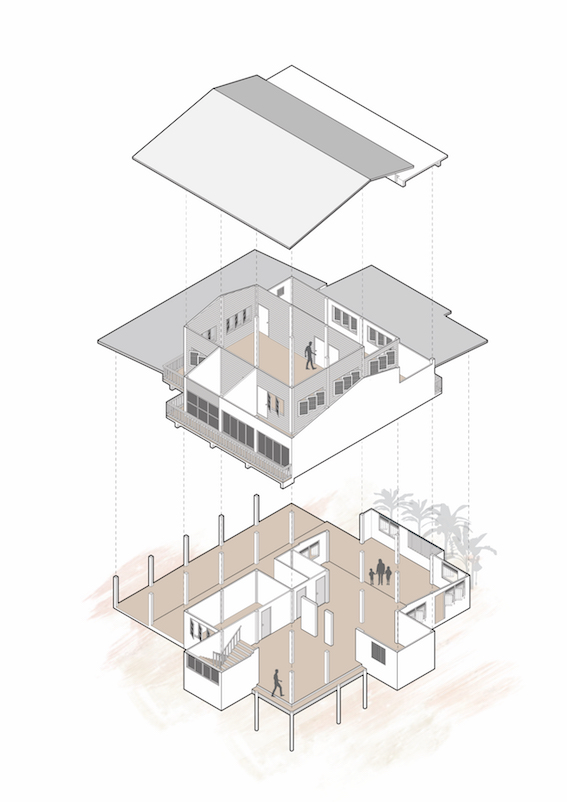Living with Water – Decoding the Local Ways of Living in the Central Region Basin of Thailand
Main Article Content
Abstract
This research aims to find out the relationships of dwelling patterns and settlements in the basin areas, to study the important factors for supporting to live with water, and to gather data, wisdom, and coping with future water disasters. The research methodology consists of reviewing theories and knowledge, surveying and interviewing 66 samples from 22 provinces in the central region, analyzing and classifying data by 6 major variables such as flooding duration, types of floods, flood elevation, characteristics of buildings, special function, and settlements. The research found that the houses which survived in flooding situation follow as: the protection, that consist of settling in the highland that is not flooded, but if inevitable, the elevated house will be the solution; the adaptation, is a guideline to preparing for life during floods; the house renovation such as extend the terrace, and house lifting. The suggestion is, the local government should to provide the risk assessment planning, floods resistant planning, include providing and updating the flooding information and coping planning after floods.
Downloads
Article Details

This work is licensed under a Creative Commons Attribution-NonCommercial-NoDerivatives 4.0 International License.
All material is licensed under the terms of the Creative Commons Attribution 4.0 International (CC-BY-NC-ND 4.0) License, unless otherwise stated. As such, authors are free to share, copy, and redistribute the material in any medium or format. The authors must give appropriate credit, provide a link to the license, and indicate if changes were made. The authors may do so in any reasonable manner, but not in any way that suggests the licensor endorses you or your use. The authors may not use the material for commercial purposes. If the authors remix, transform, or build upon the material, they may not distribute the modified material, unless permission is obtained from JARS. Final, accepted versions of the paper may be posted on third party repositories, provided appropriate acknowledgement to the original source is clearly noted.
References
Dsignsomething. (2014, June 28). DTALK: Kon Yok Ban, Dit Ban, Fang Thang Ni Kon. Retrieved September 16, 2017 from https://dsignsomething.com/2014/06/28/ก่อนยกบ้าน-ดีดบ้าน-ฟังทางนี้/.
ManagerOnline. (2013, July 23). “Ban Sathoennamsathoenbok” of National Housing Authority Suitable for Thailand and the earth trajectory. Retrieved September 23, 2017 from https://mgronline.com/greeninnovation/detail/9560000090322.
Nienhuis, A., & Stalenberg, B. (2009). Atlas of Dutch Water Cities: Settlements in river region (Hooimeijer, F., Meyer H., & Nienhuis, A., Eds.). Amsterdam: SUN.
Nillesen, A. L., & Singelenberg, J. (2011). Amphibious housing in the Netherlands: Architecture and urbanism on the water. Rotterdam: NAi Publishers.
Tengkaoprasert, R., Settaworakit, B., & Horayangkura, V. (2015). The creation of Thai architectural identity: Green architecture and sustainable development (Report report) (1st ed.). Bangkok, Thailand: G.B.P. Center.
Watson, D., & Adams, M. (2011). Design for flooding: Architecture, landscape, and urban design for resilience to climate change. New Jersey: John Wiley & Sons.
Wikimedia Commons. (2006). Terp with church and houses in Hegebeintum, the Netherlands. Retrieved September 19, 2017 from https://commons.wikimedia.org/wiki/File:Zicht_op_de_terp_van_Hogebeintum_richting_kerk,-Archeoregio_7_-_Hogebeintum_-_20425971_-_RCE.jpg.
Yodsurang, P., & Uekita, Y. (2015). A traditional community in the Chao Phraya River Basin II: Influence of water circulation on the traditional living culture according to the settlement pattern. Asian Culture and History, 8(1), 112-125.
Zevenbergen, C., Cashman, A., Evelpidou, N., Pasche, E., Garvin, S., & Ashley, R. (2010). Urban flood management. Leiden: CRC Press.


